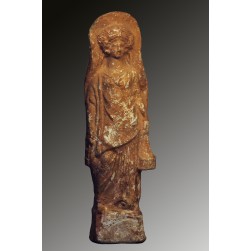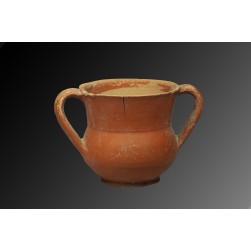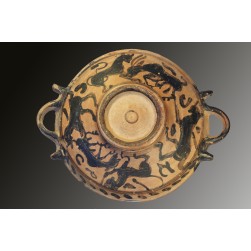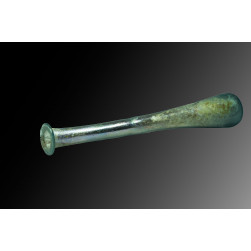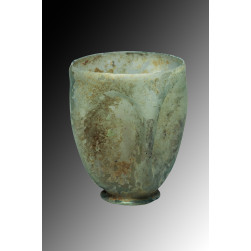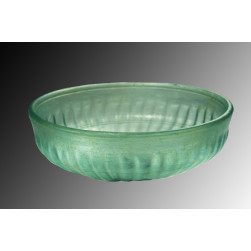No products
Product successfully added to your shopping cart
There are 0 items in your cart. There is 1 item in your cart.
Roman art is traditionally divided into two main periods, art of the Republic and art of the Roman Empire (from 27 BC on), with subdivisions corresponding to the major emperors or imperial dynasties.Roman art includes architecture, painting, sculpture and mosaic work. Luxury objects in metal-work, gem engraving, ivory carvings, and glass, are so...
Roman art is traditionally divided into two main periods, art of the Republic and art of the Roman Empire (from 27 BC on), with subdivisions corresponding to the major emperors or imperial dynasties.Roman art includes architecture, painting, sculpture and mosaic work. Luxury objects in metal-work, gem engraving, ivory carvings, and glass, are sometimes considered in modern terms to be minor forms of Roman art, although this would not necessarily have been the case for contemporaries.When the Republic was founded, the term Roman art was virtually synonymous with the art of the city of Rome, which still bore the stamp of its Etruscan art; during the last two centuries, notably that of Greece, Roman art shook off its dependence on Etruscan art; during the last two centuries before Christ a distinctive Roman manner of building, sculpting, and painting emerged. Never-the-less, because of the extraordinary geographical extent of the Roman Empire and the number of diverse populations encompassed within its boundaries, the art and architecture of the Romans was always eclectic and is characterized by varying styles attributable to differing regional tastes and the diverse preferences of a wide range of patrons.Roman art is not just the art of the emperors, senators, and aristocracy, but of all the peoples of Rome's vast empire, including middle-class businessmen, freedmen, slaves, and soldiers in Italy and the provinces. Curiously, although examples of Roman sculptures, paintings, buildings, and decorative arts survive in great numbers, few names of Roman artists and architects are recorded. In general, Roman monuments were designed to serve the needs of their patrons rather than to express the artistic temperaments of their makers.While the traditional view of Roman artists is that they often borrowed from, and copied Greek precedents (much of the Greek sculpture known today is in the form of Roman marble copies), more recent analysis has indicated that Roman art is a highly creative pastiche relying heavily on Greek models but also encompassing Etruscan, native Italic, and even Egyptian visual culture.
Greek ancient art has exercised an enormous influence on the culture of many countries from ancient times until the present, particularly in the areas of sculpture and architecture. In the West, the art of the Roman Empire was largely derived from Greek models.In the East, Alexander the Great's conquests initiated several centuries of exchange between Greek, Central Asian and Indian cultures, resulting in Greco-Buddhist art, with ramifications as far as Japan. Following the Renaissance in Europe, the humanist aesthetic and the high technical standards of Greek art inspired generations of European artists. Well into the 19th century, the classical tradition derived from Greece dominated the art of the western world.
Roman & Greek There are 12 products.
Roman bronze Rooster
The rooster stands in a proud pose, with its feet together and his crest raised. Very fine details.Price: € 1500,-- Mounted on stone stand. Size: 5,5 x 6 cm Provenance: Colletion H.P. The Netherlands
Roman bronze Bull
Bronze Apis bull. Custom mounted on wood.Price: € 1750,-- Size: 6,8 x 4,5 cm Period: 30 BC – 641 A.D. Condition: intact Provenance: Dutch private collection H.P.
Greek terracotta Kylix
Greek terracotta kylix, on small foot, decorated in black with flower motifs.price: € 450,--Size: 21 x 6 cm Period: c. 400 B.C. Provenance: acquired before 1943, by the Lochard family, Collection NL van der Noordaa RF: exhibition ‘Klassieke Kunst in Particulier Bezit’ (Leiden, 1975
Large terracotta standing female
Boeotian woman, in peplos with low kolpos, bearing a basket or incense burner. Front part from mould, back part modeled by hand; big rectangular firing hole Brown clay with white engobe; traces of red paint on base.Price: € 1250,--Size: 31 cm Period: ca 410-400 B.C.
Greek two handled cup
Orange colour cup with two large handles. Price: € 275,-- Size: 13 x 8,5 cm Period: c. 400 B.C. Material: Pottery Condition: crackline Provenance: Private Dutch collection H.P.
Boeotian lekanis
Lekanis, rim painted, row of slanting blobs, band, silhouette panthers attacking stag to left, panthers attacking goat to left, band; exterior and interior foot painted; circle at centre underside; interior painted except for tondo; exterior of reflex handles painted. Price: € 1500,-- Size; height 60 mm, rim 202 mm, foot 88 mm Period: Late 6th to 5th...
Roman glass tear bottle
Roman glass tear bottle with long slender neck and bulbous body, rounded rim.Very nice color and irrisation. Price: € 300,--Size: 13,2 x 2,3 cmPeriod: c. 100- 200 ADCondition: IntactProvenance: Belgium private collectionafter that: private collection Netherlands in 2010
Roman glass cup
Large iridescent blue-green glass cup, with pushed in bottom. Very nice condition intact. Comes with custom made stand.Price: € 800,--Size: 10,5 x 7 cmProvenance: USA collection, ex Bonhams LA
Roman folded glass cup
Roman blue green folded cup. Intact and very good condition Comes with stand.Price: € 900,--Size: 10 x 8 cm Period: c. 100 B.C. - 100 AD Provenance: USA collection, ex Bonhams LA
Etruscan group bronzes
Group Etruscan bronzes; 2 fibulas (Sanguisuga type) and a bracelet.Price for group: € 1250,--Sizes: fibulas; 9,5 x 6 and 8,5 x 5,5 cm, bracelet 8,5 x 6 cm Material: bronze Period: c. 800 - 600 BC Provenance: Dutch private collection JD
Roman glass ribbed bowl
Roman green-blue glass 42 ribbed bowl. IntactPrice: € 2500,--Size: 12,5 x 4,5 cm Material:Glass Period: 1st Century BC /1st Century AD Provnance: Dutch private collection JD
Hallstatt bracelet
Hallstatt bracelet, cas wit hollow C,with geometric designs. Beautiful patinaPrice: € 1000,--Size: 8,5 x 6 cm Period: 1050 - 800 BC Material: Copper alloy Provenance: Dutch collection JD






